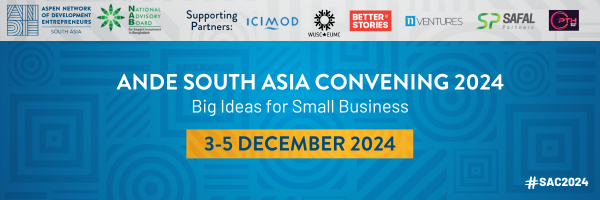
South Asia Convening 2024, Day 2: Strengthening Regional Ecosystems for Small and Growing Businesses II
Discussions highlighted strategies for scaling women-led enterprises and innovative financial metrics to enhance equitable investment strategies across the region.
For South Asia’s small businesses to thrive, inclusive growth strategies must take center stage. Day 2 of the ANDE South Asia Convening 2025 built on the momentum of Day 1, turning the spotlight on women-led enterprises and innovative investment models. The conversations underscored the urgent need to close gender financing gaps, strengthen impact measurement, and foster economic resilience in underserved communities. With insights from entrepreneurs, investors, and ecosystem builders, the day provided a roadmap for sustainable and inclusive development in South Asia.
Session 1: Growing Women-Led Ventures: From Micro to Mighty

Minhaz Anwar (BetterStories, Bangladesh) led an essential discussion on strategies to scale women-led micro and nano businesses. Addressing barriers such as gender financing gaps and unpaid care work, he emphasized capacity-building, access to capital, and mentorship as critical factors for success.
Dr. Tariqul Islam (Max Foundation) introduced Nusrat Lamia, an entrepreneur from Bangladesh whose resilience transformed her family’s food business into a thriving health and hygiene venture during the COVID-19 crisis. Her success now empowers 27 other entrepreneurs, showcasing the power of grassroots leadership.
Dr. Dilip Bhandari (Heifer International) highlighted Nepal’s rural impact enterprises, stressing the importance of sustainable agriculture, market access, and financial inclusion. Meanwhile, Anagha Kamath (Mann Deshi Foundation) shared the inspiring journey of Vanita Pise, a woman entrepreneur who overcame financial hurdles and now mentors others in India’s first women-led rural bank.
This session reinforced that financial inclusion and impact investments are crucial for fostering women-led businesses. By equipping women with capital, networks, and tools, their enterprises can drive transformative economic and social change across South Asia.
Session 2: Population-Weighted Asset Under Management
With economic disparities and financial inclusion challenges persisting in South Asia, the concept of Population-Weighted Assets Under Management (PWAUM) presents a compelling new approach to investment allocation.

Farhad Reza (NAB Bangladesh) introduced PWAUM, arguing that financial impact should be measured not only by revenue but by its reach and effectiveness in serving large populations.
Tasfia Tasneem Ahmed (BIGM) provided a case study demonstrating how regional investment should factor in population density and socio-economic needs, ensuring a more equitable allocation of resources. Olav Muurlink (CQUniversity) expanded on the discussion, emphasizing that impact data should be contextualized within local realities to maximize its effectiveness.
Dr. Rahul Mathew (World Vision Bangladesh) explained how PWAUM, when combined with Social Return on Investment (SROI), can direct capital toward high-impact initiatives in education, healthcare, and financial inclusion. Nick Goryl (PlentyOne Global) argued that PWAUM challenges outdated development models by shifting investment focus from global priorities to locally driven needs.
The session made clear that rethinking financial metrics can reshape South Asia’s investment landscape, driving more equitable and targeted impact funding.
Looking Ahead
Day 2 of #SAC2024 underscored the power of innovative finance and inclusive investment to create systemic change. The momentum behind women-led enterprises and population-weighted financial models is growing, but achieving lasting impact will require sustained investment, policy shifts, and collective action. The insights shared at ANDE’s convening must now translate into concrete commitments from investors, policymakers, and ecosystem players. The future of South Asia’s entrepreneurial landscape depends on our ability to turn these discussions into action.
